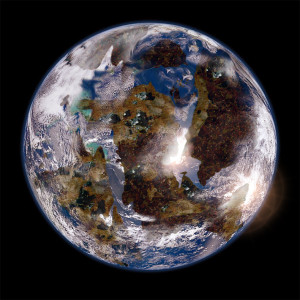12 December 2311
The starship Boreal returned from the system Pi 1 Ursae Majoris (HR 3391) to report some of the most unusual life forms yet discovered in the search for human-habitable planets. The planet’s unusual vegetation paints a landscape of perennial autumn colors. Green chlorophyll colors Earth’s land plants, while on Yom, the chemicals that turn light and air into plant material are red, orange, or yellow.
Even more unusual is the planet’s animal life. On all the habitable planets discovered to date, advanced animal forms have one plane of symmetry. On the new planet, all advanced species have three planes of symmetry, each at 120° angles to each other. These planes divide each animal into three sections that resemble each other and meet along a central axis.
The second planet orbiting HR 3391 is slightly smaller than Earth with a lower gravitational attraction at the surface. A smaller fraction of the surface is covered by oceans, giving the planet nearly the same land area as Earth. At nearly 27 hours, the planet’s day is 13 percent longer than Earth’s, and daily temperature swings are generally higher.

Captain Zenon Benon and the crew of the Boreal recommend against sending human settlers to the new planet because one of its species may be capable of developing an advanced civilization. The final decision about whether to settle the planet must be made by Earth International Council on Space Exploration or possibly by the full GAIL High Council. Follow this link for additional information.
